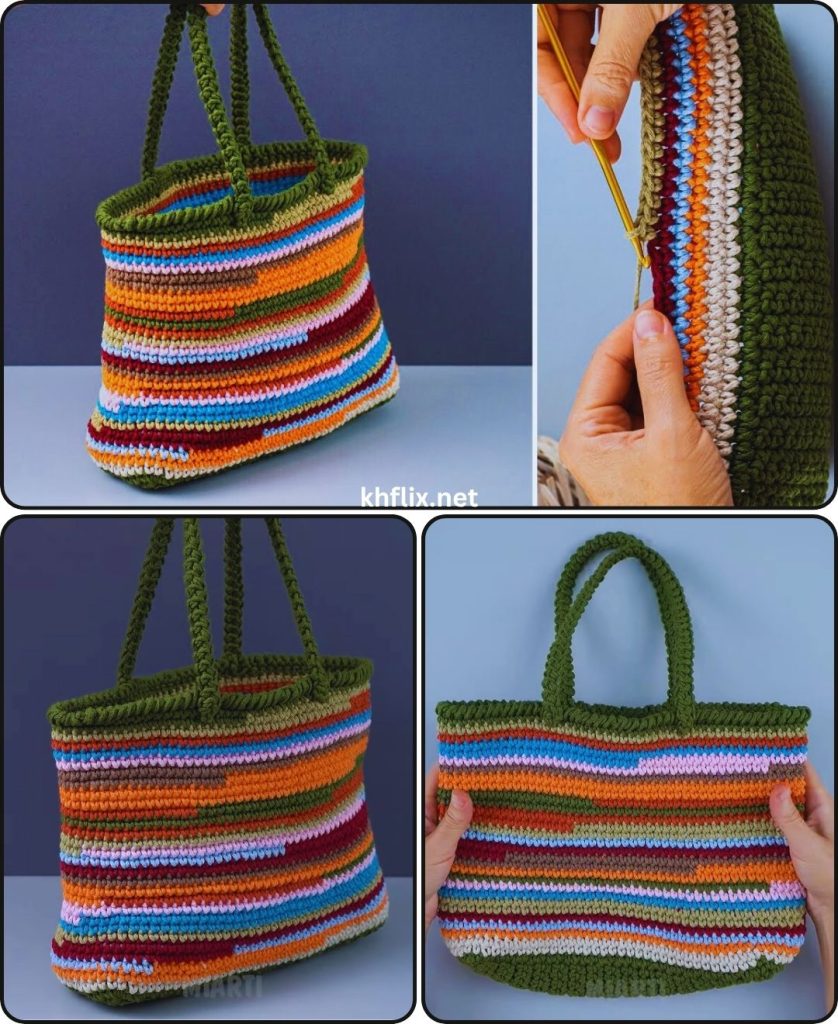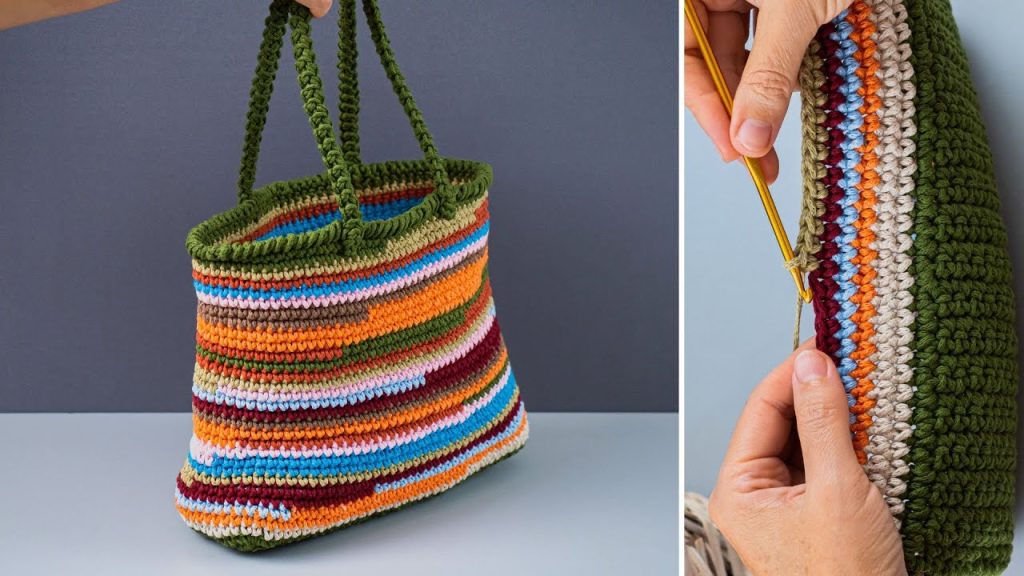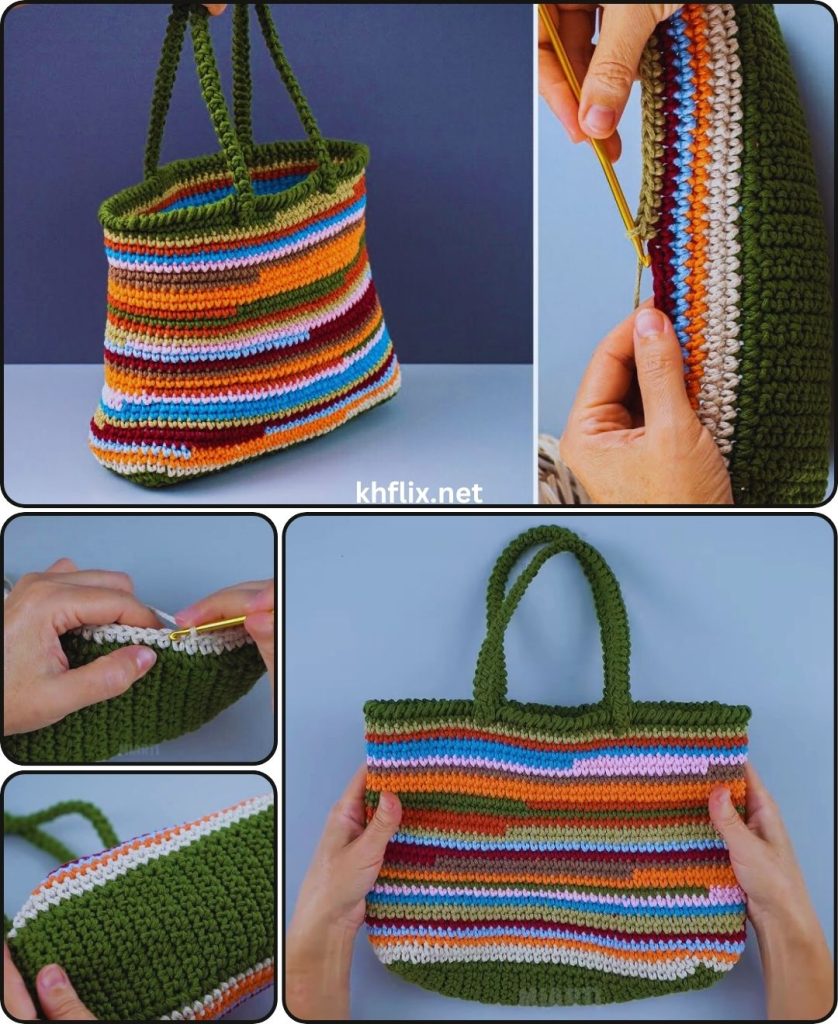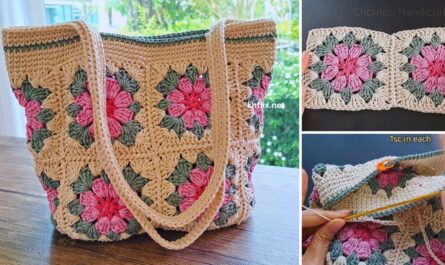Let’s transform those beautiful yarn scraps into a vibrant and unique striped tote bag! This project is a fantastic way to use up all those leftover bits of yarn you’ve accumulated, creating a truly one-of-a-kind bag that’s both eco-friendly and stylish. It’s a surprisingly easy and incredibly satisfying project for beginners and beyond, as the “stripes” will naturally emerge from your random color choices.

How to Crochet a Striped Tote Bag from Yarn Scraps Easily
This detailed tutorial will guide you through making a colorful and practical tote bag using simple stitches and a straightforward construction method. The beauty of a scrap yarn project is that there’s no “wrong” way to mix colors, making it a stress-free and creative endeavor!
Skill Level: Beginner
This project is perfect if you’re comfortable with (or ready to learn!):
- Chain (ch): The basic foundation.
- Single Crochet (sc): A dense and sturdy stitch, ideal for bags.
- Slip Stitch (sl st): For neatening and joining.
- Changing colors: An easy technique that you’ll do often with scraps!
- Working in rows: Crocheting back and forth.
- Fastening off: Securing your work.
- Weaving in ends: The essential finishing touch (and there will be many!).
- Basic seaming: Joining two edges with a yarn needle.
Finished Tote Bag Dimensions (Approximate):
Using worsted weight yarn scraps and the suggested hook, your finished tote will typically measure around 12-14 inches (30-35 cm) wide and 14-16 inches (35-40 cm) tall (excluding the strap). This is a versatile size for everyday use, groceries, or carrying craft supplies.
Materials You’ll Need:
Gathering your materials beforehand makes for a smoother crocheting experience.
- Yarn Scraps: A glorious assortment of Worsted Weight (Medium #4) Cotton or Cotton Blend Yarn. This is the star of the show!
- Quantity: You’ll likely need about 400-600 yards (365-550 meters) total. Don’t worry about precise measurements for individual colors; just gather all your bits.
- Why Cotton/Cotton Blend? As mentioned in previous tutorials, cotton yarn is fantastic for bags because it’s durable, has minimal stretch, and holds its shape well. Using various fibers might make the bag stretch unevenly, so sticking to similar yarn weights and fiber types (like all cotton or all acrylic) is best, but a mix can also work for a truly unique look!
- Color Strategy: Embrace the randomness! Let your scraps dictate the stripes. You might have some larger balls for main sections and smaller bits for thin accent stripes.
- Crochet Hook: Size H/5.0mm. This hook size works well with worsted weight yarn to create a dense fabric for your bag.
- Yarn Needle (Tapestry Needle): Absolutely essential for seamlessly weaving in all those loose yarn tails (you’ll have quite a few with a scrap project!) and for seaming the bag panels together. It has a blunt tip and a large eye.
- Scissors: Any pair of sharp scissors.
- Stitch Marker (Optional): Useful for marking the end of rows, especially when you’re just starting out and changing colors frequently.
Understanding the Tote Bag Construction: Simple Panels
This tote bag is built in a straightforward manner using two main panels and a strap:
- Two Identical Panels: You’ll crochet two flat rectangular panels that will form the front and back of your bag. These will be your “scrap yarn canvases” where the striped effect comes alive.
- Seaming: The two panels will be sewn together along three sides (bottom and two sides) to create the bag’s body.
- Strap: A sturdy crocheted strap will be added to the top edges for carrying.
This “panel construction” method is beginner-friendly because you’re always working in flat rows, which is often easier to manage than working in the round.
Let’s Crochet Your Scrap Yarn Striped Tote Bag!
The key here is to have fun with color changes! Don’t overthink it. When a color runs out or you feel like a change, just switch to a new scrap.

Part 1: Crocheting the Front and Back Panels (Make 2)
These are the main pieces of your bag. We’ll use single crochet (sc) throughout for a strong, durable fabric.
- Starting Chain (with any scrap color):
- Make a slip knot with your first scrap color and place it onto your H/5.0mm crochet hook.
- Chain (ch) 41. (This determines the width of your bag. If you want a wider bag, chain more; for a narrower bag, chain less. Your stitch count in the following rows will be one less than your starting chain.)
- Row 1 (Current Scrap Color):
- Work 1 single crochet (sc) into the 2nd chain from your hook.
- Continue to work 1 sc into each remaining chain across the entire row. You should end up with a total of 40 single crochet stitches.
- Chain 1 (ch 1) (this turning chain does NOT count as a stitch; it simply gives height for the next row).
- Turn your work.
- Color Changing Technique (at the end of any row):
- This is the fun part with scraps! You’ll change colors frequently.
- Work the last single crochet stitch of the current row as normal, but stop when you have two loops left on your hook.
- Drop the current color. Pick up your next scrap color.
- With the new scrap color, yarn over and pull through both loops on your hook to complete the stitch. The new scrap color is now active on your hook.
- Chain 1 (using the new scrap color), then turn your work. You are now ready to work the entire next row in your new color.
- Creating the Striped Panels (Approximate for 35 rows total):
- Continue to work 1 sc into each sc across every row.
- At the end of every 1, 2, 3, or 4 rows (or whenever your current scrap runs out, or you feel like a change!), perform the color change technique described above.
- Total Rows: Aim for approximately 35 rows to create a panel that’s roughly 14-16 inches tall.
- Important: Don’t worry about keeping track of the exact number of rows per color. The beauty of a scrap yarn project is its organic, random stripe pattern!
- Yarn Carrying (Optional): For very short stripes (1-2 rows), you can gently carry the non-working yarn up the side of your work by laying it along the top of the previous row and crocheting over it. However, with many color changes, it’s often cleaner to simply cut the yarn and weave in the ends later.
- Fasten Off:
- After completing your last row (Row 35, or when your panel reaches the desired height), cut your yarn, leaving a tail about 6-8 inches (15-20 cm) long.
- Yarn over with your hook, pull the cut tail completely through the loop left on your hook, and gently tug to secure the knot.
- Repeat all these steps to make a second identical panel. You should now have two uniquely striped rectangles.
Part 2: Assembling the Bag Body
This is where your two flat, striped rectangles transform into a 3D bag!
- Align the Panels:
- Lay your two crocheted panels on top of each other. Make sure the “right sides” (the side you prefer to be visible on the outside of your bag) are facing inward.
- Align all the edges perfectly.
- Seaming the Sides and Bottom:
- Thread a new, long length of yarn onto your yarn needle. Pick a scrap color that complements your overall palette, or a neutral. Make sure the tail is at least 40-50 inches (100-125 cm) long – it’s better to have too much than too little for seaming.
- Starting from one of the bottom corners (where the width of the panel meets the height), begin to stitch the two panels together.
- Use a simple whip stitch (insert your needle from front to back through both loops of both panels, then repeat, wrapping the yarn around the edge) or a mattress stitch (which creates a more invisible seam). For beginners, the whip stitch is usually easier.
- Stitch all the way up one side of the bag, across the bottom edge, and then up the other side. Aim to go through both loops of the stitches on both panels for a strong, sturdy seam.
- Ensure your corners are neat and square. You might make an extra stitch or two in the corners to reinforce them and help them turn smoothly.
- Continue stitching until the entire three sides (both vertical sides and the horizontal bottom) of your bag are securely joined.
- When you reach the end of your seam, secure the yarn by making a small knot close to the fabric, then weave in the remaining tail neatly into the seam itself or into the fabric. If you run out of yarn during seaming, simply join a new long piece and continue.
- Tip: Take your time with seaming. Neat seams make a huge difference in the finished look of your bag. Using stitch markers to hold the panels together before you start sewing can also be very helpful.

Part 3: Crocheting and Attaching the Shoulder Strap
A comfortable and sturdy strap is essential for carrying your tote. For simplicity, we’ll suggest a solid strap in one of your more abundant scrap colors, or you can even stripe the strap too!
- Crocheting the Strap (with a consistent scrap color):
- Pick a scrap color you have a decent amount of (or join a few similar colors if you prefer a striped strap).
- Make a slip knot.
- Chain (ch) 101. (This will create a strap of about 25-30 inches / 64-76 cm, which is a good length for a shoulder bag. Adjust this chain length for a longer or shorter strap if desired.)
- Row 1: Work 1 sc into the 2nd ch from your hook. Work 1 sc into each remaining ch across. You should have 100 sc.
- Chain 1, turn.
- Rows 2-4: Work 1 sc into each sc across the row. You will still have 100 sc in each row.
- Chain 1, turn. (You can make more rows here if you want an even wider, thicker strap.)
- Fasten off, leaving a very long tail (at least 15-20 inches / 38-50 cm) at each end of the strap for sewing.
- Attaching the Strap to the Bag:
- Lay your bag flat and find the top opening.
- Position the ends of your crocheted strap on the inside of the bag’s top opening. A good placement is to center them above where the side seams are, or slightly inward (about 1-2 inches / 2.5-5 cm in from the top corners of the bag).
- Thread one of the long tails from the strap onto your yarn needle.
- Stitch firmly back and forth, going through the strap end and into the top edge of the bag. Make sure to go through multiple stitches and layers for a very strong attachment. Work your needle in a way that the stitches are discreet from the outside.
- Repeat this process for the other end of the strap, ensuring the strap is not twisted before you stitch it down.
- Weave in all remaining strap tails very securely into the top edge of the bag.
Part 4: Final Finishing Touches
- Weave in ALL Remaining Ends:
- This is the most crucial (and often the longest!) step for a professional-looking, durable bag, especially with a scrap yarn project. You’ll have tails from your starting chains, all your color changes, and the final fasten-offs.
- Use your yarn needle to meticulously weave in every single loose yarn tail.
- How to Weave Neatly: Thread the yarn tail onto your yarn needle. Weave the tail into the stitches of the same color as the tail. Go in one direction for at least 1.5-2 inches (4-5 cm). To truly secure it, subtly change direction (e.g., weave along a row, then turn and weave back through some of the same stitches diagonally or perpendicularly) to “lock” the tail in place and prevent it from unraveling. Trim any excess yarn close to the fabric, being careful not to cut any of your actual stitches.
- Blocking (Optional but Highly Recommended):
- Blocking can significantly improve the shape, even out any tension inconsistencies, and give your bag a more polished, professional look. It makes a big difference with cotton yarn!
- Method (Wet Blocking – Ideal for Cotton/Cotton Blends):
- Gently mist your entire bag evenly with cool water using a spray bottle until it’s damp but not soaking wet.
- Carefully stuff your bag with clean towels or crumpled paper to help it hold its desired shape while drying.
- Smooth out any wrinkles and gently shape the bag, ensuring the seams lay flat and the stripes look even.
- Allow the bag to air dry completely and thoroughly in a well-ventilated area. This can take several hours to a full day, depending on humidity and ventilation. Ensure it’s bone dry before handling or using it.
Congratulations! You’ve successfully crocheted a beautiful and functional striped tote bag from yarn scraps! This handmade accessory is not only practical but also an incredible way to reduce waste and create something truly unique. Enjoy your stylish new creation! What will you fill it with?




